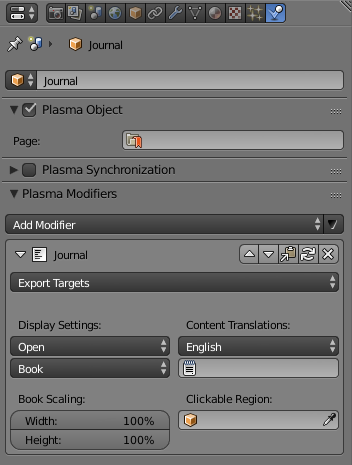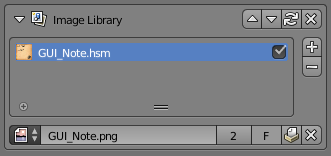Korman:Journals
| This is a tutorial page.Versions available: PyPRP; 3ds Max; Korman. |
Journals are a good way to convey story, characters, and exposition to the explorers who find your Age. These journals can appear either as an aged and yellowed book, or as a newer notebook containing lined paper. The simple journal modifier available in Korman allows you to choose which of these your journal will use, as well as allowing you to automatically export correctly for the different versions of Uru with only a small amount of initial configuration.
Contents
[hide]Simple Journals
To create a simple journal, you will need the book object to which you will attach the modifier. Build and texture your journal's mesh and place it in your Age as you want it to appear to explorers.
With your journal object selected, go to the Properties window and select the Physics panel.
Click on Add Modifier and select Journal, found in the GUI group. The defaults should have your journal ready for export in most cases. You will only need to select the Uru version(s) to which you intend to export, and fill in the value which specifies the journal contents (see Content Options below).
The available options will change dynamically based on which Uru version(s) you select as targets in the Export Targets dropdown. You can configure as many versions as you like, and Korman will automatically use the appropriate options when you export.
Appearance Options
These options change how the UI pop-up element of the journal is displayed to the explorer.
- Start: The start position specifies whether the book should, when clicked, start closed showing the cover, or opened and showing the first pages. If you are not providing a cover for your journal, you should use the Open option.
Applies to: Uru: Ages Beyond Myst, Myst Online: Uru Live
- Book Type: The Book Type determines the type of page that Uru will use to fill your journal. Book uses the yellowed pages, while Notebook uses the white, lined paper.
Applies to: The Path of the Shell, Myst Online: Uru Live
- Book Scaling: If you have an unusually thin or wide journal object and wish the journal UI to match it, you can scale it down in width and/or height here.
Applies to: The Path of the Shell, Myst Online: Uru Live
Content Options
Each version of Uru has a slightly different way to access journal contents. As of Korman 0.08, Korman will manage journal contents for you. To do so, you will provide a Blender text file with the journal contents. You can provide multiple translations for the journal by using the drop down.
- Language: Select the name of the language you would like to specify the journal contents for.
- Text File: Provide the text file whose contents should be used for the journal contents in the specified language.
Journal Contents
The journal's contents and some elements of its appearance are specified through a text file. To format the text of your journal (e.g. choose a new font), see the Plasma esHTML reference page. To customize the cover see the Plasma esHTML section on Journal Covers. A journal must have a cover provided through this method for it to appear closed, otherwise it will always start open regardless of the setting in Appearance Options.
NOTE: Journal modifiers created with Korman 0.07 or lower will only be partially updated. You will have to manually provide the journal contents.
Lets assume you have created a journal you can edit the content in a the text window of Blender or edit an external file and cut and paste the content from some external word processor like Microsoft Word note however you need to set your word preferences to use the simple apostrophy mark the curly one Word uses by default is not recognised in the blender text editor dispite appearing in a pasted document.
I have found the simpilest method if you are using Word is to paste your finnished text into a plain text document using something like word pad then in your Blender file open this .txt file with the text editor within blender when there are differences between the text within blender and your external .txt file you will see a life saver ring next to the toolbar selection icon
As you can see you have 3 choices
1) Reload the external file and overwrite the onboard text. 2) Save to disk overwrite the existing external with the current internal. 3) Break the link to the external file.
I personaly keep all of my .txt files in a sub directory of my age building folder called Book Texts
Region Options
By default, the simple journal modifier will automatically create a six-foot cubic clickable region centered around your journal's mesh.
If a special region is required for your journal, you can override this by providing your own. Simply create a region object and select it in the provided Region field.
Images
If your journal is going to contain images, either as the cover or as interior illustrations (i.e., the Minkata journal), you can use the Image Library Modifier to attach them. This modifier ensures any images it contains are exported despite having no physical presence in your Age.
With your journal object selected, go to the Properties window and select the Physics panel. Click on Add Modifier and select Image Library, found in the GUI group. Click the + button to add a slot for the new image you wish to add to the library. Select the new slot, and from the image picker below the list, you can select either images you have already imported into Blender, or open a new file directly. Repeat adding a slot and selecting or loading an image for each new image you wish to add to the journal.
Note: The name for each image will be changed upon export; this modified name is displayed in the list's entry for each image.
When adding each image to your journal, keep in mind that on export your images will be converted to a Plasma-specific image format with the '.hsm' suffix, and that's how they will be seen in the Image Library list. For example, if you add an image named GUI_Note.png to the library, it will be exported as GUI_Note.hsm. Therefore, the source attribute of the image tag in your journal must use this finalized suffix (e.g., <img src="GUI_Note.hsm"> ) and not the original suffix, GUI_Note.png.


